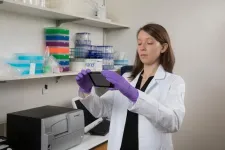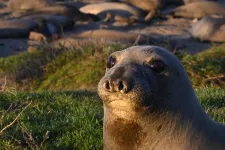(Press-News.org) BINGHAMTON, N.Y. -- Your body is ground zero for a cellular arms race.
Your mitochondria, red blood cells and immune system rely on iron to function; so do invading viruses and bacteria. As your body evolves safeguards for this most critical resource, these safeguards select for invaders that can overcome them.
“Iron is physiologically useful in catalyzing reactions, such as binding oxygen, because it both donates and accepts electrons,” explained Binghamton University Associate Professor of Anthropology Katherine Wander, the first author of a recent paper on the topic.
“Iron nutrition and COVID-19 among Nigerian healthcare workers” appeared in the journal Evolution, Medicine, and Public Health. Wander’s 34 co-authors include personnel from Nigerian hospitals and universities; Binghamton doctoral students Meg Gauck in anthropology and Zifan Huang, who assisted in data curation and analysis; Mei-Hsiu Chen, Binghamton’s director of Statistical Consulting Services; and Associate Professor of Africana Studies Titilayo Okoror, who aided in funding acquisition and project administration.
COVID-19 represented an intriguing opportunity for study. As a novel virus, it had less opportunity to adapt to human physiology — and less time in the evolutionary arms race.
The study focused on healthcare workers in four Nigerian hospitals working in coronavirus wards during the pandemic’s Delta wave. Most of them had Astra Zeneca vaccinations at this point, Wander said.
The war for iron
The body uses iron in multiple ways, from immune function to catalyzing reactions in mitochondria, which produce cellular energy in the form of adenosine triphosphate (ATP).
Iron, famously, is what gives red blood cells their color. Red blood cells use a protein called hemoglobin to transport oxygen. Hemoglobin, in turn, is made of smaller proteins known as heme, which contain an iron molecule that binds and transports the oxygen.
“Our pathogens need iron for the same reasons,” Wander explained. “A virus hijacks the cellular machinery to make more virus. Often, viruses increase the cellular uptake of iron.”
Simply put, naturally high levels of iron offer needed resources for your body’s cells, but it also becomes available to pathogens, promoting their spread. As a result, we have evolved layered, overlapping mechanisms to keep iron under control, while pathogens continually evolve ways to overcome these obstacles.
In an evolutionary sense, the pathogens have the advantage.
“Even in the best of circumstances, our immune system can’t adapt as fast as something with a generation time of 20 minutes,” said Wander, referring to iron sequestration mechanisms. “Bacteria and viruses are able to turn over new generations so quickly that their evolution just happens faster.”
In biological anthropology, the optimal iron hypothesis refers to a purported “sweet spot” that reduces susceptibility to infection, while mostly meeting the body’s iron needs.
The research in Nigeria showed that individuals with plentiful iron in their system did have a higher risk of catching COVID, as well as people who had anemia. But mild or moderate iron deficiency, however, didn’t seem to protect against infection in and of itself.
The case study of COVID-19 suggests that even very early in the arms race — when an infectious disease is emerging and still very new to humans — iron nutrition tradeoffs are in play.
“Any additional increment of iron is going to come with both potential benefits in terms of immune defense and potential risk from an infectious agent,” Wander said. “The trade-off is always there, but the optimal level is going to shift depending on the infectious disease environment.”
This tradeoff is potentially one of the reasons why iron deficiency is common even in otherwise well-nourished populations, particularly among women.
The body tends to conserve iron, recouping 80% of the iron contained in senescent blood cells. We’re not, however, particularly efficient at absorbing iron, and dietary factors can interfere with this process.
“Humans seem to be vulnerable to iron deficiency, and we try to solve that problem by helping people improve their iron intake and iron absorption,” Wander said. “It’s hard to do.”
END
Evolutionary tradeoffs: Research explores the role of iron levels in COVID-19 infections
Biological anthropologist studies the ‘arms race’ over a critical resource
2025-02-13
ELSE PRESS RELEASES FROM THIS DATE:
Ecological Society of America selects 2025 EEE Scholars
2025-02-13
The Ecological Society of America (ESA) announces the 2025 cohort of ESA Excellence in Ecology (EEE) Scholars. This prestigious scholarship program celebrates and supports outstanding early- to mid-career Ph.D. ecologists from groups traditionally underrepresented in the scientific community.
This year’s EEE Scholars are: Elvira D'Bastiani, Postdoctoral Researcher at the University of California, Los Angeles; Gabriela Garcia, Assistant Professor at Northeastern University; Camille Griffith, Assistant Professor at Oglala Lakota College; and Estelí Jiménez-Soto, Assistant Professor at the University of South Florida.
“These exceptional scholars embody ...
U.S. stream network is longer during annual high-flow conditions
2025-02-13
Rivers and streams may look permanent, but their lengths can change dramatically with the seasons, according to a new study. It reports that stream networks in the United States expand up to five times their low-flow size during wet conditions. The findings offer the first large-scale insights into how water dynamically moves through landscapes and provide a framework for forecasting climate-driven changes in stream networks, particularly in response to increasing storminess. Traditionally regarded as ...
Seismic techniques reveal how intense storms in 2023 impacted aquifers in Greater Los Angeles
2025-02-13
Despite record rainfall in the region in early 2023, only a fraction of Southern California’s groundwater reserves has been replenished, researchers report. Their study, which leverages seismic noise data from across Greater Los Angeles, highlights the urgent need for improved monitoring and management of the state’s critical groundwater reserves. After enduring two decades of severe drought, California experienced an abrupt meteorological shift in water in 2023. A succession of 16 atmospheric rivers from late 2022 through early 2023, followed by the torrential ...
Elephant seals in the Pacific serve as deep-ocean sentinels, revealing patterns otherwise hard to measure
2025-02-13
Northern elephant seals may hold the key to unlocking the secrets of the open ocean’s twilight zone (~200 – 1,000 meters deep). According to a new study, these deep-diving creatures can help estimate fish abundance by providing a rare window into the elusive prey dynamics in one of the planet’s most mysterious and remote ecosystems. Ecosystems are dynamic, with resource fluctuations – natural or human-induced – shaping species interactions and food webs. These processes are well studied in terrestrial ecosystems but not in deep, open ocean ecosystems, ...
Depression linked with higher risk of long-term physical health conditions
2025-02-13
Adults with a history of depression gain long-term physical conditions around 30% faster than those without, according to research publishing February 13th in the open-access journal PLOS Medicine. Kelly Fleetwood of the University of Edinburgh, United Kingdom, and colleagues argue that their study suggests depression should be viewed as a ‘whole body’ condition, and integrated approaches should be used to manage mental and physical health.
Depression is the most common mental health condition and ...
Los Angeles groundwater remained depleted after 2023 deluge, study finds
2025-02-13
The greater Los Angeles area has long been subject of intense seismographic monitoring. A network of highly sensitive seismometers peppers the region on a constant vigil for earthquakes. Now researchers at the Stanford Doerr School of Sustainability have developed a new way to use that existing infrastructure and its decades of data to estimate water levels in the region’s aquifers, which serve some 10 million residents of Los Angeles and Orange counties.
The researchers analyzed the ...
Foraging seals enable scientists to measure fish abundance across the vast Pacific Ocean
2025-02-13
EMBARGOED until Thursday, Feb.13, 2025, at 2 P.M. U.S. Eastern Time
SANTA CRUZ, Calif. – Over the past 60 years, marine biologists at UC Santa Cruz have monitored the behavior of northern elephant seals that journey to nearby Año Nuevo Natural Reserve. With the seals gathering on the beach by the thousands to breed and molt, generations of researchers have been able to amass more than 350,000 observations on over 50,000 seals.
With the help of powerful technologies and the intrepidness to get close ...
Dessert stomach emerges in the brain
2025-02-13
To find the cause of the "dessert stomach", the researchers investigated the reaction of mice to sugar and found that completely satiated mice still ate desserts. Investigations of the brain showed that a group of nerve cells, the so-called POMC neurones, are responsible for this. These neurones become active as soon as the mice were given access to sugar which facilitated their appetite.
When mice are full and eat sugar, these nerve cells not only release signaling molecues that stimulate satiety, but also one of the body's own opiate: ß-endorphin. This acts on other nerve cells with opiate receptors and triggers a feeling of reward, ...
Fungus ‘hacks’ natural immune system causing neurodegeneration in fruit flies
2025-02-13
A fungal infection has been shown to trigger a fruit fly’s own immune system to destroy brain cells leading to signs of neurodegeneration, a new study has found.
The paper published in PLOS Biology today found that a fungus called Beauveria bassiana was able to make the fly’s innate immune system trigger a process that kills neurons and glia in the brain, leading to more than half of flies dying after seven days compared to half of control samples living for nearly 50 days.
In experiments conducted by a team of academics from the University of ...
A new view on 300 million years of brain evolution
2025-02-13
Leuven, 14 February 2025 – In a new study published in Science, a Belgian research team explores how genetic switches controlling gene activity define brain cell types across species. They trained deep learning models on human, mouse, and chicken brain data and found that while some cell types are highly conserved between birds and mammals after millions of years of evolution, others have evolved differently. The findings not only shed new light on brain evolution; they also provide powerful tools for studying how gene regulation shapes different cell types, across species or different disease states.
Our brain, and by extension ...
LAST 30 PRESS RELEASES:
Collaborative study uncovers unknown causes of blindness
Inflammatory immune cells predict survival, relapse in multiple myeloma
New test shows which antibiotics actually work
Most Alzheimer’s cases linked to variants in a single gene
Finding the genome's blind spot
The secret room a giant virus creates inside its host amoeba
World’s vast plant knowledge not being fully exploited to tackle biodiversity and climate challenges, warn researchers
New study explains the link between long-term diabetes and vascular damage
Ocean temperatures reached another record high in 2025
Dynamically reconfigurable topological routing in nonlinear photonic systems
Crystallographic engineering enables fast low‑temperature ion transport of TiNb2O7 for cold‑region lithium‑ion batteries
Ultrafast sulfur redox dynamics enabled by a PPy@N‑TiO2 Z‑scheme heterojunction photoelectrode for photo‑assisted lithium–sulfur batteries
Optimized biochar use could cut China’s cropland nitrous oxide emissions by up to half
Neural progesterone receptors link ovulation and sexual receptivity in medaka
A new Japanese study investigates how tariff policies influence long-run economic growth
Mental trauma succeeds 1 in 7 dog related injuries, claims data suggest
Breastfeeding may lower mums’ later life depression/anxiety risks for up to 10 years after pregnancy
Study finds more than a quarter of adults worldwide could benefit from GLP-1 medications for weight loss
Hobbies don’t just improve personal lives, they can boost workplace creativity too
Study shows federal safety metric inappropriately penalizes hospitals for lifesaving stroke procedures
Improving sleep isn’t enough: researchers highlight daytime function as key to assessing insomnia treatments
Rice Brain Institute awards first seed grants to jump-start collaborative brain health research
Personalizing cancer treatments significantly improve outcome success
UW researchers analyzed which anthologized writers and books get checked out the most from Seattle Public Library
Study finds food waste compost less effective than potting mix alone
UCLA receives $7.3 million for wide-ranging cannabis research
Why this little-known birth control option deserves more attention
Johns Hopkins-led team creates first map of nerve circuitry in bone, identifies key signals for bone repair
UC Irvine astronomers spot largest known stream of super-heated gas in the universe
Research shows how immune system reacts to pig kidney transplants in living patients
[Press-News.org] Evolutionary tradeoffs: Research explores the role of iron levels in COVID-19 infectionsBiological anthropologist studies the ‘arms race’ over a critical resource



